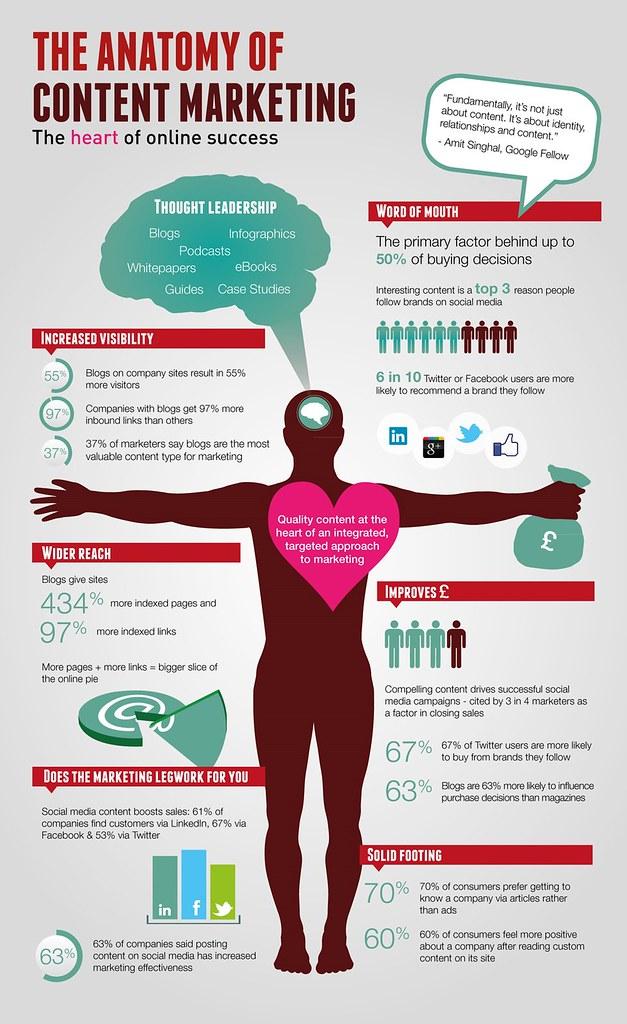Content marketing is quickly becoming a mainstay in the advertising market, and for good reason. As traditional methods of advertising become increasingly difficult to navigate, savvy marketers and businesses are shifting their focus to content marketing to keep up with the changing times. From boosting engagement to creating meaningful relationships with their audience, content marketing has limitless potential in transforming ordinary businesses into successful ones. Get ready to see how content marketing is taking the world of marketing by storm!
1.Understanding Content Marketing
Content marketing involves the creation and sharing of educative, entertaining, and useful content for the purpose of attracting and engaging customers. It is a strategic process that focuses on addressing consumers’ needs and interests instead of bluntly advertising a product or service. Content marketing cuts across many media channels, including blogs, white papers and infographics. In many ways, it can be viewed as a shift away from traditional advertising, as it requires an ongoing relationship with customers that traditional tactics do not.
- Educative and Engaging – Content marketing needs to provide an educative and engaging experience for the consumer. People are driven to content that is useful and can help solve their problems or answer their questions. This often requires active customer research, as marketers must know what their customers are looking for. Content should provide detailed and comprehensive information to customers in order to capture their attention and shape their opinions.
- Targets Specific Audience – Traditional marketing often attempts to reach a broad audience results in limited effectiveness. Content marketing, however, allows marketers to target specific audiences. This allows marketers to create detailed customer personas and customize their content marketing strategies accordingly.
- Become an Authority – One of the benefits of content marketing is that it allows marketers to position themselves as experts or authorities in their target markets. This helps to establish trust with customers, increasing the chance that they will visit the company’s website or make a purchase. This process should focus on providing value to customers in order to build lasting relationships.
Content marketing can be highly effective, but it must be executed properly in order to stand out from the competition. Marketers should remember to focus on providing educative and engaging content that is tailored to their specific target markets. By shifting away from traditional advertising tactics and embracing the power of content marketing, marketers can reach the right audiences with the right message.
2.Exploring the Benefits of Content Marketing
Why Content Marketing?
With the rise of digital technology, traditional advertising is no longer the only way to promote your business. Content marketing offers several advantages over traditional methods, including cost savings and heightened engagement.
- Cost Savings: Content marketing costs significantly less than traditional advertising. Since content marketing typically involves creating digital content, such as videos, blog posts, and social media posts, there are no direct printing or distributing costs.
- Heightened Engagement: Consumers interact with content marketing in a more meaningful way. A blog post will not only be seen by potential customers but will also be commented on or shared, increasing visibility and providing an opportunity to further engage with the target audience.
- Increased Brand Awareness: Unlike traditional advertising, content marketing is centered around educating and informing prospective customers. This means that potential customers will have a more positive perception of your brand, leading to increased brand awareness.
- Improved SEO Visibility: Content marketing increases visibility in search engine results pages (SERPs). Since search engines prefer content that is often updated, regularly publishing content will help to increase your ranking in the SERPs over time.
In conclusion, content marketing can be a powerful and effective way to reach your desired audience. It offers significant cost savings over traditional advertising, increased brand awareness and a heightened level of engagement. Additionally, content marketing will improve your rankings in the SERPs, making sure potential customers can easily find your business online.
3.Traditional Advertising vs. Content Marketing
Traditionally, businesses relied on advertisements to reach target audiences through television, radio, print, and other forms of promotion. These traditional techniques can help make a customer aware of a company’s presence. However, they lack the outreach of content marketing.
Benefits of Content Marketing Over Traditional Advertising
- Cost Effective: Content marketing can be significantly cheaper than traditional advertising.
- Targeting: Content can be tailored to specific audiences, helping to create more targeted campaigns.
- Builds Trust: Content marketing helps build relationships with customers by providing them with educational and engaging information.
- Search Engine Optimization: Content rich in relevant keywords can help boost visibility and rank in search engine result pages.
- Measurable Results: Content marketing can track the performance of campaigns, providing valuable insights for future efforts.
As technology advances, companies are beginning to shift away from traditional advertising methods to new ways of marketing. Content marketing offers a cost effective and targeted approach, and can be especially beneficial in the digital age. Companies can create content that engages with customers and encourages them to continue their interaction with the company. Content that is informative and entertaining can help build trust between business and customer, encouraging them to return and become a lasting loyal customer.
4.Content Marketing Strategies
- Define Your Target Audience – When you want to make the shift from traditional to content marketing, the need to define your target audience is absolute. What data do you need to access to understand your target audience? Some key metrics to look into are demographics, psychographics, interests, location and frequency of purchase.
- Set Clear and Realistic Goals – Content marketing is done for multiple purposes. You need to determine what kind of goals you wish to achieve. Whether it is brand awareness or generating leads, it is necessary to accurately define what you want to get out of the content.
- Focus on Quality Over Quantity – Quality content is the backbone of any content marketing strategy. With quality and informative content, you can capture and retain audience attention for long. Consider creating both short-form and long-form pieces of content. By adding visuals, stories and videos, you can amplify your chances of reaching out to a bigger audience.
- Monitor and Measure Results – Monitoring your content marketing results is essential. It gives you an idea of ROI, what works and what could be improved. You could make use of several analytic tools to track the performance of your content marketing campaigns. You should measure and analyze different elements like views, likes, clicks, conversions, etc.
- Let Technology Do the Work – The use of AI has made content marketers’ lives simpler. You can now use AI to create content, conduct a complete SEO audit, monitor engagement rate on content and get personalized recommendations on content. Technology is now making it more predictable to get good ROI on content marketing, something that was difficult in the early days.
- Engage with Your Audience – One of the most effective is engaging with your audience. You could incorporate user-generated content in your campaigns and leverage the customer voice. You should also leverage influencers to create quality content for your audience. This can help to boost brand visibility as well as build lasting relationships with the customers.
5.Efficient Content Distribution Platforms
Content marketing is a powerful way to break through the noise of traditional advertising. It allows for more creative and targeted campaigns that create meaningful connections with customers. With the right tools and platforms, content can be distributed among a wide range of audiences, resulting in significantly more engagement than digital advertising.
1. Social Media Platforms
Social media platforms offer a great way to quickly disseminate content in a cost-effective way. It’s an easy way to target specific audience, allowing you to reach those who are likely to be interested in your content. With enough reach, you can gain valuable insights into customer behavior and physical locations, arming you with the information to improve your content. You can also create enhanced content, such as boosted posts and sponsored stories, to ensure maximum visibility for your message.
2. Content Aggregators
- Feedly
Content aggregators are platforms that allow you to collect, organize, and distribute content quickly. By using them, you can send your content to multiple sites and readers with a single click. This helps you disseminate your message to a wide range of audiences and gain traction in multiple places. Additionally, by engaging with readers through comments and feedback, you can build relationships that result in loyal followers.
3. Email List
- MailChimp
- Constant Contact
Email lists are becoming increasingly popular for content marketers. They allow you to send your content directly to your subscribers’ inboxes, developing relationships with them and giving them direct access to what you have to say. Additionally, email campaigns can easily be adapted and tailored, and you can measure their success with detailed analysis. With the right tools, many companies are finding creative ways to use email lists to successfully reach potential customers.
4. Paid Search
- Google Adwords
- Bing Ads
Paid search is a great way to drive traffic and engagement to your content. It allows you to target extremely specific keywords and phrases that people are using to find your content. By using different platforms, you can also tailor your campaigns to focus on the right people and ensure you get the best return on investment. With the right approach, you can create highly targeted campaigns that will ensure maximum visibility and engagement.
5.
- Outbrain
- Taboola
Efficient content distribution is one of the most effective ways to ensure your content reaches the right people quickly and effectively. Content distribution platforms like Outbrain and Taboola allow you to promote your content on hundreds of high-quality sites, reaching a massive audience and driving more traffic and engagement to your content. With its powerful algorithms, these platforms can target the right readers, increase visibility, and even help you increase revenue.
6.Optimizing Content for Maximum Reach
Discover the Easiest Way to Optimize Content
If your small business is choosing content marketing as a viable alternative to traditional advertising, you need to optimize your content for maximum reach. While having the right idea is essential, you also need to ensure your message reaches its intended audience in a timely and effective manner.
Fortunately, isn’t as difficult as it might first appear. Here are some easy steps to get you started:
- Know your audience and craft your content accordingly. Imagine who is most likely to be interested in your content and create it with them in mind.
- Select topics that are trending or highly searched. Keep an eye on trends as well as analytics to help you craft your content accurately and effectively.
- Understand what type of content works best for your audience. Despite what content platform you’re using, you should always monitor user behavior and engagement to see what type of content performs the best.
- Be sure to format appropriately. Depending on the type of post you’re writing, use formatting such as bulleted lists, subheadings and whitespace to make your content readable and visually appealing.
- Include relevant keywords. Keywords are a great way to optimize content for reach. Using related keywords correctly will help boost your content’s visibility, not to mention your SEO rankings.
- Stay on top of the latest trends. Keeping an eye on trends and adjusting your content accordingly will ensure your content stays relevant and up-to-date.
isn’t rocket science, but it’s essential if you’re planning to shift from traditional advertising to content marketing. Of course, content marketing isn’t just about creating content – it’s also about making sure the right people see it, understand it, and engage with it.
By following the steps listed above, you’ll be well on your way to making sure your small business content reaches the right audience.
7.Essential Metrics for Measuring Impact
Content marketing is quickly becoming one of the most powerful tools for acquiring and engaging customers. As brands move away from traditional advertising and into content marketing, it’s important to measure success and identify areas for improvement. Here are seven essential metrics for measuring the impact of content marketing.
Engagement Rate
- This metric measures how engaged users are with the content. It can be calculated by dividing total engagements (likes, shares, comments, etc.) over total impressions.
- High engagement rates demonstrate that your content is resonating with users.
Traffic
- Traffic to content marketing channels such as blogs websites, email, and social media can be measured to indicate the reach and success of content marketing efforts.
- Look for an increase in users over time and measure the views per user, indicating they are consuming more. Also look for an increase in page views and overall dwell time.
Conversion Rate
- This metric measures how successful content is at converting interest into conversions such as sign-ups or purchases.
- Look for variation in the conversion rate per content platform for more insights.
Share of Voice
- This metric compares the amount of content relevant to a brand’s area of focus that an individual or organization has against its competitors.
- Look at industry mentions, tagș shares, sentiment scores, and more to determine a company’s share of voice.
Lead Generation
- Total leads generated from various content channels can be measured to gauge the amount of business content marketing is bringing in.
- Make sure to track specific leads generated from content efforts.
Reach
- Total potential reach of content should be measured, including the following: impressions, unique visitors, page views, video views, shares, and subscriptions.
- Focus on increasing organic reach, as well as views and clicks from promoted content.
Cost per Lead
- Calculate the cost per lead by dividing the total marketing investment by the number of leads generated. The lower the cost per lead, the better.
- Look at the cost per lead per channel to determine which provides the best return on investment.
8.Maintaining Content Relevance
Content marketing works best when it’s targeted and properly timed. As the needs of your customers change, it’s important to keep your content fresh and relevant. Here are a few tips for maintaining relevance in your content marketing:
- Conduct regular audits: Regularly audit your content to ensure it’s up-to-date and relevant to your target audience. Use analytics to measure the performance of your content, identify any content gaps, and replace outdated content.
- Leverage emerging trends: Experiment with new content formats and topics to keep your content dynamic and captivating. Follow industry trends to create timely content that resonates with your audience.
- Stay social: Social media is an important platform for staying connected with your audience and understanding how they’re engaging with your content. Monitor social conversations and use the insights you gather to improve existing content and create new content that your customers are interested in.
- Encourage feedback: Encouraging your audience to share feedback on your content is key in maintaining relevance. Ask questions and engage with your audience to get their opinions on your content and incorporate their suggestions and ideas into future content.
By regularly auditing and refreshing your content, staying up to date with industry trends, utilizing social media, and engaging with your audience, you can ensure your content is always relevant and effective.
9.Preparing for the Evolving Face of Content Marketing
Content marketing is an ever-evolving space, filled with new and exciting opportunities to engage customers, turn leads into sales and scale your business. The face of content marketing, however, is quickly changing, and it’s important to be knowledgeable and prepared for the future.
As digital media advances, content marketing campaigns have begun to look more like traditional advertising. They’re becoming more direct, with data-driven methods to target audienceship and create personalised campaigns, rather than more general broadcasts.
One of the biggest shifts is the move from content hubs such as blogs and websites, to content-driven social media platforms. This means content now must work to capture the attention of users who are being bombarded with updates, notifications, and targeted ads.
Businesses have to be more creative in how they deliver content. Here are a few tips to keep in mind:
- Get creative with visuals: By representing ideas and messages with videos, infographics, images and other forms of media, content will be more likely to stand out.
- Use interactive content: Interactive content such as quizzes or polls are more likely to engage users and drive brand awareness.
- Analyse, refine, and repeat: Just as in traditional advertising, content marketing analytics provide key insights into what works and what doesn’t. Be sure to keep track of these metrics in order to continually refine your content approach.
It is important for businesses to keep up with the ever-evolving face of content marketing. By understanding the current trends, and staying creative with content, businesses can reap the benefits of stronger engagement with their customers and leads.
Content marketing is truly a revolution in the world of advertising – a much needed step towards cutting edge marketing. As marketers continue to transform into content creators to reach a larger audience, it’s crucial to stay informed on the dynamics of this growing technique. Content marketing has irreparably changed the way we advertise and it is up to us to take advantage of the big shift and make sure traditional advertising remains part of our strategy.








Leave a Comment